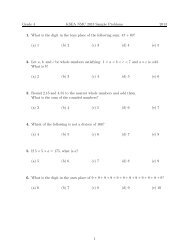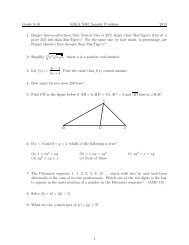Download KSEA Letters 40-3, Apr. 2012 [pdf] - Korean-American ...
Download KSEA Letters 40-3, Apr. 2012 [pdf] - Korean-American ...
Download KSEA Letters 40-3, Apr. 2012 [pdf] - Korean-American ...
You also want an ePaper? Increase the reach of your titles
YUMPU automatically turns print PDFs into web optimized ePapers that Google loves.
TECHNICAL ARTICLES<br />
MICROSTRUCTURALLY DESIGNED HIERARCHAL ALUMINUM METAL MATRIX COMPOSITES<br />
[Yongho Sohn]<br />
Professor, Materials Science and Engineering<br />
University of Central Florida, Orlando<br />
INTRODUCTION<br />
Nanostructured Al-alloy based MMCs have gained considerable interest due to their excellent properties (i.e., high strength, low<br />
density, good corrosion resistance), and their technical and economical ease of manufacturing. Recently, a hierarchal MMC consisting<br />
of a nanocrystalline Al phase (NC-Al), boron carbide (B4C) reinforcement particles, and a coarse-grain Al phase (CG-Al) has<br />
been successfully fabricated and reported to exhibit extremely high compressive yield strength ( > 1 GPa) and tailorable ductility<br />
(~ 15%) [1,2]. In particular, high strain-rate dependent materials have found their way into aerospace, automotive, biomedical, and<br />
defense application. These properties are achieved through control of the microstructure that is dependent on parameters of materials<br />
processing and manufacturing. The hierarchical Al-MMCs exhibit good thermal stability and microstructural characteristics<br />
that deflect or blunt or bridge crack propagation. The microstructure and properties can be further customized through the use of<br />
friction stir processing [3] which offers a variety of possibilities for joining components of dissimilar geometry, modified and graded<br />
microstructure and composition.<br />
MATERIALS PROCESSING AND MANUFACTURING<br />
The commercial gas-atomized AA5083 Al powder has an average particle size of less than 45 μm with a grain size ranging from 0.2<br />
to 2 μm. The B4C powder has a starting particle size between 1 to 7 μm. The 5083 Al powder is combined with B4C powder and cryomilled<br />
for up to 24 hours. The powders are ball-milled in the presence of liquid N2 to increase friability, prevent oxidation and mitigate<br />
dynamic recrystallization. Commercially available stearic acid is utilized as a process-control agent during milling to prevent excessive<br />
agglomeration of the powders and improve yield. Cryomilling is a key step that produces the Al grain size down to 20-30 nm<br />
[4,5], disperses the B4C into the Al matrix and creates the NC-Al/B4C bond. Other strengthening mechanisms are generated during<br />
this process including dislocation entanglement, dispersoids strengthening and complex interface development. After cryomilling,<br />
additional AA5083 powder (CG-Al) is blended with the cryomilled mixture, which in turn creates the hierarchal MMC powders.<br />
The powder samples are degassed<br />
through a rotary dynamic vacuum<br />
degassing system. The degassed<br />
powders are then consolidated into<br />
billets with established powder metallurgy<br />
techniques such as vacuum<br />
hot pressing, cold isostatic pressing,<br />
or hot isostatic pressing. Secondary<br />
processing is achieved through<br />
conventional wrought processing<br />
techniques such as extrusion, forging,<br />
and/or rolling. Figure 1 illustrates<br />
the complete manufacturing<br />
processing steps of the hierarchal Al<br />
Figure 1. Manufacturing sequence of hierarchal Al metal matrix composites<br />
MMCs examined in this study.<br />
NOVEL MICROSTRUCTURAL FEATURES OF HIERARCHAL COMPOSITES<br />
Extensive microstructural and spectroscopic analyses were carried out as a function of processing parameters. The properties of<br />
hierarchal Al MMCs were influenced by multiple microstructural features including: (1) volume (or weight) fraction of each constituent,<br />
NC-Al, CG-Al and B4C; (2) grain size and distribution of the NC- and CG-Al; (3) size and distribution of the B4C particle<br />
reinforcement; (4) size and distribution of hierarchal microstructural domains, e.g., CG-Al and B4C/ NC-Al agglomerates; (5)<br />
dislocation densities the in NC- and CG-Al; (6) composition, distribution and structure of nitrogen incorporated during cryomilling<br />
either in solution or as a dispersoid reinforcement; (7) characteristics of grain boundaries and interfaces (e.g., NC-Al and B4C,<br />
NC-Al and CG-Al, CG-Al and B4C); (8) other impurity-associated strengthening by solution or dispersion reinforcements.<br />
10<br />
<strong>KSEA</strong> LETTERS Vol. <strong>40</strong> No. 3 <strong>Apr</strong>il <strong>2012</strong>


![Download KSEA Letters 40-3, Apr. 2012 [pdf] - Korean-American ...](https://img.yumpu.com/23972233/12/500x640/download-ksea-letters-40-3-apr-2012-pdf-korean-american-.jpg)
![Download KSEA Letters 40-2, Jan. 2012 [pdf] - Korean-American ...](https://img.yumpu.com/23972281/1/190x245/download-ksea-letters-40-2-jan-2012-pdf-korean-american-.jpg?quality=85)
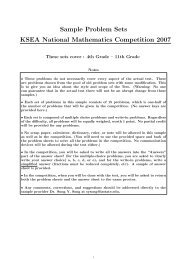
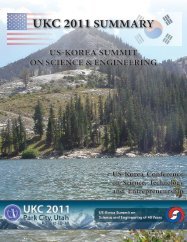

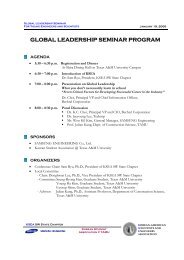
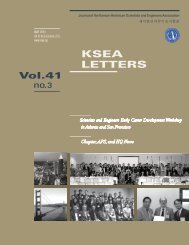



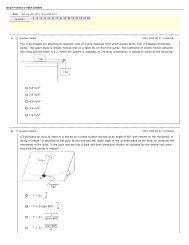
![Download KSEA Letters 40-4, Jun. 2012 [pdf] - Korean-American ...](https://img.yumpu.com/23972210/1/190x245/download-ksea-letters-40-4-jun-2012-pdf-korean-american-.jpg?quality=85)

